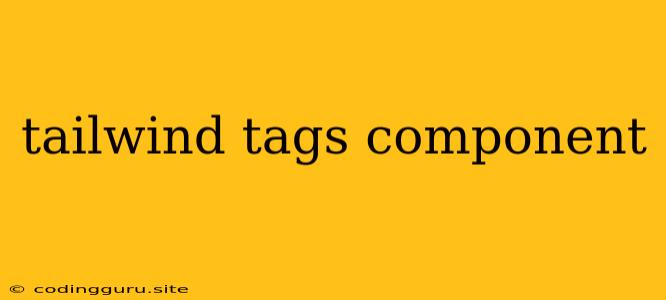Tailwind CSS: Styling Your Tags with Grace
Tailwind CSS is a utility-first CSS framework that empowers developers to create beautiful and responsive designs without writing a lot of custom CSS. One of the key components in designing effective web interfaces is the humble <span> tag, often used to highlight specific pieces of text. But how can you leverage Tailwind CSS to make these tags truly stand out and enhance your website's aesthetic appeal?
The Power of Tags in Web Design
Tags are often used to:
- Categorize content: Think of tags like labels for your website's content, helping users easily find what they're looking for. For example, blog articles can be tagged with relevant topics like "technology," "travel," or "lifestyle."
- Highlight keywords: You can use tags to emphasize important keywords within text, making them more prominent and visually distinct.
- Create interactive elements: Tags can be styled as buttons or links, providing users with an interactive way to engage with your content.
Tailwind CSS: Your Styling Toolkit for Tags
Tailwind CSS offers a wealth of utility classes that you can use to style your tags in numerous ways, giving them a unique look and feel. Here's how you can use Tailwind to create beautiful and functional tags:
1. Basic Styling:
bg-*: Use thebg-*classes to set the background color of your tag. Choose from a wide range of predefined colors, likebg-blue-500,bg-green-300, orbg-gray-200.text-*: Thetext-*classes let you define the text color. Pick a contrasting color for your text to ensure readability.font-*: Specify the font size, weight, and style of your tag's text using classes likefont-bold,font-medium, ortext-lg.px-*: Control the padding of your tag to create visual breathing room between the text and the tag's edges usingpx-*classes likepx-2orpx-4.
2. Shape and Appearance:
rounded-*: Create rounded corners for a softer look using classes likerounded-mdorrounded-fullto make your tags resemble badges or pills.border-*: Add a border to your tags usingborder-*classes. Customize the color, width, and style of the border using classes likeborder-gray-300,border-2, orborder-dashed.shadow-*: Give your tags depth and visual emphasis using theshadow-*classes. Choose from a variety of shadows likeshadow-mdorshadow-lg.
3. Interactivity and Engagement:
hover-*: Change the tag's appearance on hover usinghover-*classes. For example, you could add a subtle background color change on hover usinghover:bg-blue-100or increase the size of the tag usinghover:scale-110.active-*: Adjust the tag's style when it's being clicked or pressed usingactive-*classes. This could include changing the background color, adding a subtle shadow, or reducing the size of the tag.
Example: Implementing Tailwind Tags
Let's see how these Tailwind classes come together in practice:
Technology
Travel
This code snippet creates two tags: one with a blue background and the other with a green background. Both have rounded corners, padding, and a hover effect that slightly darkens their background color.
4. Beyond Basic Styling: Using Tailwind's Advanced Features
Tailwind's capabilities extend beyond basic styling. You can utilize its advanced features to create even more sophisticated and customizable tags:
- Customizing color palettes: Create your own custom color palettes and assign them to your tags using Tailwind's
@applydirective. - Responsive design: Tailor the look of your tags based on screen size using Tailwind's responsive modifiers like
sm:,md:, andlg:. - Creating reusable components: Extract your tag styles into separate component files to promote code reusability and maintainability.
5. Tailwind Tags: A Powerful Tool for Visual Design
By mastering Tailwind CSS's styling capabilities, you can elevate the look and feel of your tags and create visually engaging website experiences for your users. Tailwind provides a comprehensive toolkit for styling your tags in countless ways, enabling you to communicate information effectively and enhance your website's overall aesthetic appeal.
Conclusion
Tailwind CSS is an invaluable tool for styling tags effectively, giving you the freedom to create unique and visually captivating design elements. By harnessing Tailwind's utility classes, you can craft tags that are not only visually appealing but also functional, enhancing the user experience of your website. Experiment with Tailwind's features, explore its customization options, and discover the endless possibilities for creating stunning and interactive tags that make your website stand out.
